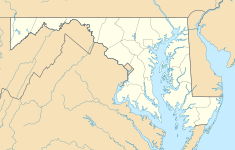| Worthington's Range | |
|---|---|
| Nearest city | Clarksville, Maryland |
| Coordinates | 39°12′07″N76°56′31″W / 39.20194°N 76.94194°W Coordinates: 39°12′07″N76°56′31″W / 39.20194°N 76.94194°W |
| Architectural style(s) | Log house, Gambrel |
Worthington's Range, "Howard's Chance", "Howard's Range", or "Tierney Gambrel Roof House", is a historic slave plantation located between Clarksville, Columbia and Simpsonville in Howard County, Maryland, United States.

Plantations are an important aspect of the history of the American South, particularly the antebellum era. The mild subtropical climate, plentiful rainfall, and fertile soils of the southeastern United States allowed the flourishing of large plantations, where large numbers of workers, usually Africans held captive for slave labor, were required for agricultural production.

Clarksville is an unincorporated community in Howard County; the second wealthiest county in the United States according to the U.S. Census Bureau. The community is named for William Clark, a farmer who owned much of the land on which the community now lies and served as a postal stop that opened on the 4th of July 1851.

Columbia is a census-designated place in Howard County, Maryland, United States, and is one of the principal cities of the Baltimore metropolitan area and the Washington metropolitan area. It is a planned community consisting of 10 self-contained villages. It began with the idea that a city could enhance its residents' quality of life. Creator and developer James W. Rouse saw the new community in terms of human values, rather than merely economics and engineering. Opened in 1967, Columbia was intended to not only eliminate the inconveniences of then-current subdivision design, but also eliminate racial, religious and class segregation.
Rachel Worthington ( - 1776) settled the site in 1753, carving out 369 acres of "Worthington's Range" from her husbands existing slave plantation. The house is the birthplace of Paul Griffith Stromberg. The "Miller Cemetery" lies about two hundred feet Northwest from the house. It was destroyed by arson in 1977. [1]
Paul Griffith ("Pete") Stromberg was the owner since 1940 and editor since 1920 of "The Howard County Times", founded 1840 in Ellicott City, Maryland, the county seat of Howard County, which later grew into a syndicate of local community newspapers known as the "Stromberg Newspapers" in Howard County, Anne Arundel County, Prince George's County, Baltimore County and Baltimore City. He also was a Maryland State Senator from Howard County in the General Assembly of Maryland.
In 2014, former Howard County Department of Planning and Zoning director's firm Land Design and Development petitioned the planning board to subdivide the historic property and cemetery for a 150 unit housing development called "Enclave at Tierney Farm". Density was increased by having the county extend sewer service to the rural property. The project was delayed a single year because of an indefinite lack of school capacity in the region. [2]

The Howard County Department of Planning and Zoning (DPZ) manages planning and development in Howard County, Maryland, a Central Maryland jurisdiction equidistant between Baltimore,Maryland and Washington, D.C.






